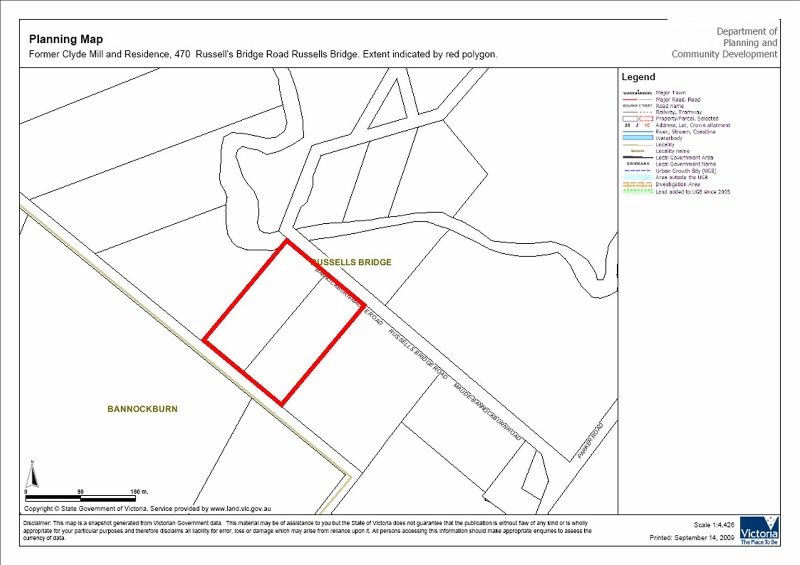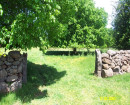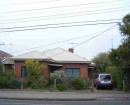Clyde Flour Mill and Managers Residence
470 Russell's Bridge Road, RUSSELLS BRIDGE VIC 3331 - Property No 40100070
-
Add to tour
You must log in to do that.
-
Share
-
Shortlist place
You must log in to do that.
- Download report





Statement of Significance
What is Significant?
The Clyde Mill and former Manager's Residence, also known as Clydebank or Clydesville, is located on the south bank of the Moorabool River approximately 3.5 km due north of Bannockburn at a locality called Russell's Bridge. The small settlement was developed from as early as 1838 by George Russell, manager of the Clyde Company as the Moorabool outstation, part of its vast squatting holdings centered on Golf Hill. The first bridge was built in 1842 at his direction. An 1856 plan of the Clyde Company's holdings, showing existing buildings, just before a major land sale, includes the mill as well as the bridge, the outstation huts and the Clyde Hotel all of which the Company owned. In 1856, Walter Webb purchased two properties adjacent to the bridge. Later, in November 1857, Webb sold off one portion to Allan Fraser and, with Thomas Dann, a Geelong miller, began to construct a steam powered flour grinding mill. Dann claimed in 1888 that he and Webb erected the Clyde Mill and that he lived there at least until 1888. The milling and produce firm Harvey Dann & Co. Pty Ltd continued in Geelong until 1987. Whether for Russell or for themselves, the partners developed a substantial stone building to house the machinery, ordered from England by Webb. Flour milling was one of the fundamental food processing industries in the colony and, in its early days, had to be located close to where wheat was grown and water was available for power. By the late nineteenth century, flour milling was focused in the western suburbs of Melbourne close to railway line which brought wheat from distant centres in the newly opened Wimmera/Mallee. As well as a three-storied mill, there was an office, a boiler house with a brick chimney, a house and a number of sheds. The Moorabool River provided water for the steam boiler, which a new owner, Bird installed in July 1859. Bird held the property until December of that year and then sold it to William Hannam. The mill apparently continued to work until the final death throes of the nearby Steiglitz goldfields at the turn of the century, although from time to time over the next few years, local farmers were able to mill their flour. The mill gradually fell into disrepair. In 1937, William Hannam sold it to Thomas Gent, who was owner until 1962. There were a number of other owners until 1978, when the property was purchased by the current owners who undertook major repairs and renovations. Today, most of the mill and manager's residence remain. The old mill, which has clearly changed over the years including the loss of equipment and lean-tos and other additions, is now used as a storage facility and the manager's residence as a private residence. The vernacular house has been extended several times but retains its simple form and humble scale unembellished after the decline of the milling business. While the intactness and integrity of both buildings are compromised both are in very good condition. Of interest is the early forged iron cooking equipment in the former kitchen hearth. There is a mature garden which complements the structures.
How is it Significant?
The Clyde Mill and former Manager's Residence is of historical and architectural significance to the state of Victoria.
Why is it Significant?
The Clyde Mill and former Manager's Residence is of historical significance as one of the few surviving examples of an early and substantial steam flour mill, a type of food processing which was essential to the colonial economy. It is significant for its associations with the district generally and specifically the nearby gold field of Steiglitz. It is of particular significance for its historical associations with the Clyde Company and George Russell, at least indirectly, and the Geelong miller, Thomas Dann. It is of architectural significance for its traditional form which still demonstrates the industrial processes once used for milling and for the vernacular residence of the manager.
-
-
Clyde Flour Mill and Managers Residence - Physical Description 1
The Clyde Mill at Russell's Bridge is located on the south side of the Moorabool River close to the bridge crossing of the Clyde Hill-Maude Road. The complex still comprises several structures, the most important being the three-storey stone mill and the single-storey weatherboard residence, both of which have been changed by additions, partial demolitions and other alterations. Formerly there was also a pair of workers cottages between the mill and the river. The complex is set within a well-established garden including several important mature trees. The main buildings are not quite aligned.
The mill is a simple industrial structure with a gabled roof including an attic storey, now clad with corrugated iron. The bluestone masonry is roughly coursed with better dressed rock-faced stones used as quoins at the corners, at the sides of windows and as sills and lintels. Formerly there was a partially enclosed timber lean-to verandah around the base. This has been replaced by a double-gabled extension curiously divided by a glazed door and built of much better masonry than the mill itself. There was also a tall chimney in the south-east corner. A large door opening to the exterior at the rear from the first floor suggests that some structure, possibly a timber staging, has been removed from that elevation. The small-paned glazing of the mill is probably modern.
The dwelling comprises a stone wing, possibly the earliest part, and a timber wing built in several stages. All the roofs are painted corrugated iron. The stone wing has been built in two stages and has the finest masonry facing the mill. The further section has brick quoins around the window rather than the bluestone quoins in the earlier section. A skillion extends beyond the further end. The stone wing incorporates a large chimney in the middle which notably still includes its earliest cooking equipment: a crane for hanging pots and pans over the open fire. The chimney stack is now pressed red brick and must have been rebuilt. The first timber section appears to have been the symmetrical central section with small rooms and a rear passage connecting to the stone wing. It has a verandah with a timber floor and timber posts with simple timber brackets. There are two additional gabled pavilion ends, that closer to the mill being doubled and incorporating a modern verandah. The gable fascias are decorated with simple solid loops. Almost all of the windows are 12-paned double-hung sashes except for the front window of the section closest to the mill which is a pair of 8-paned double-hung sashes. The louvre window shutters are modern. The interiors of the residence remain significantly intact.
The edge of the paved drive is edged with rounded river stones. The traditional front garden includes several mature trees such as Fraxinus spps. (Ash trees), a large Ficus macrophylla (Moreton Bay Fig), and smaller plantings such as Rosa spps., camellia, hydrangea, agapanthus, melianthus, pelargonium and daisies. Elsewhere there are a Schinus molle (Peppercorn), Ulmus spps (English [?] Elm) and small modern fruit trees. Elms have suckered extensively close to the bridge.
Clyde Flour Mill and Managers Residence - Historical Australian Themes
3 Developing Local, Regional and National Economies
3.5 Developing primary production
3.5.3 Developing agricultural industries
3.8 Moving goods and people
3.8.4 Making economic use of inland waterways
3.11 Altering the environment
3.11.5 Establishing water supplies
3.12 Feeding people
3.12.2 Developing sources of fresh local produce
3.12.4 Preserving food and beverages
3.12.5 Retailing foods and beverages
3.13 Developing an Australian
manufacturing capacity
5 Working
5.1 Working in harsh conditions
5.1.2 Coping with dangerous jobs and workplaces
8 Developing Australia's Cultural Life
8.12 Living in and around Australian homes
8.14 Living in the county and rural settlements
Clyde Flour Mill and Managers Residence - Physical Description 2
Clyde Mill and former Manager's Residence to the extent of the whole of the mill including its interiors and the residence but excluding its interiors, and all of the land comprising Allotment 1A, Section 15, Parish of Wabdallah.
Clyde Flour Mill and Managers Residence - Integrity
While the intactness and integrity of both buildings are compromised both are in very good condition.
Heritage Study and Grading
Golden Plains - Golden Plains Shire Heritage Study Phase 2
Author: Heritage Matters P/L
Year: 2009
Grading: State
-
-
-
-
-
Former Presbyterian Church
 Golden Plains Shire
Golden Plains Shire -
Former Russells Bridge State School No. 530
 Golden Plains Shire
Golden Plains Shire -
Russells Bridge over Moorabool River
 National Trust
National Trust
-
-








